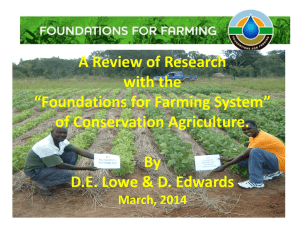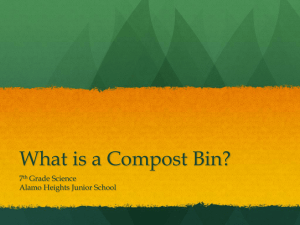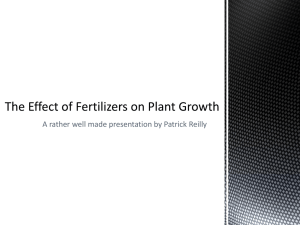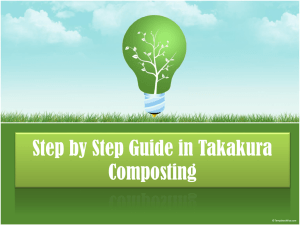nabeel ahmad ikram,Evaluating different nitrogen sources for
advertisement
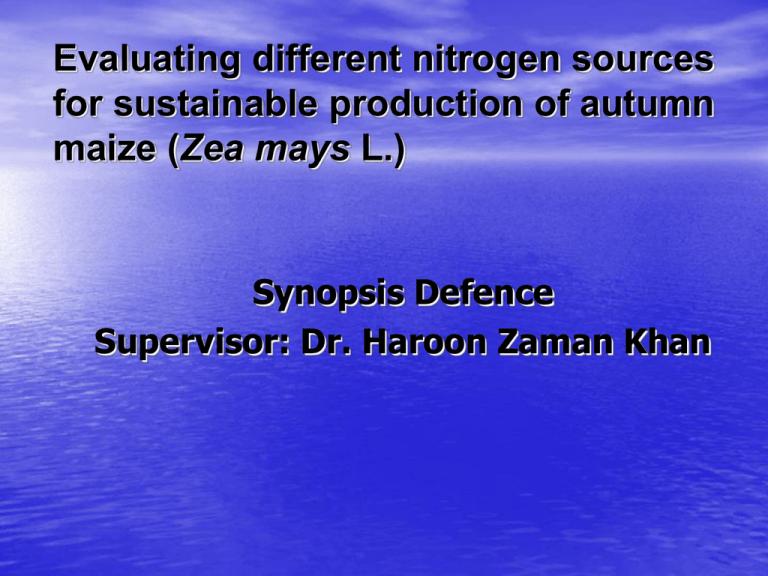
Evaluating different nitrogen sources for sustainable production of autumn maize (Zea mays L.) Synopsis Defence Supervisor: Dr. Haroon Zaman Khan Maize Important cereal crop (Chaudhary, 1983) Cultivated area = 950 thousand ha Annual production = 3,341 thousand t (Govt. of Pakistan, 2010-2011) Serves as, food for human; feed for livestock & poultry; and raw material for agro-based industries (Tariq et al., 2002) Importance of N • Plant normally contain 1 to 5% by weight of N. • Essential component of Amino acid. • Integral component of chlorophyll and enzymes. • Building block of plant tissues. • Stimulation of root growth and uptake of other nutrients. • Imbalance use of nitrogen can cause delaying maturity, effect the availability of P, K and S. • Chances of lodging. • More chances of insect attack. (Anonymous, 2000; Belger et al., 1978) Role of N in maize • LAI • Stem diameter • LAD • Grain size • Quality & quantity of grain • Stover yield • No. of grains per cob • Plant height • 1000 grain weight • Grain protein (Tisdale et al., 1990) Causes of low yield of maize Poor/Improper soil preparation Use of unapproved seed/variety Improper irrigation Weed infestation Insect attack Less or no appl. of manure The sub-optimal & imbalanced use of nutrients (Ahmad and Muhammad, 1998) Problems associated with sole application of chemical fertilizers & organic manure Chemical fertilizers Health hazards Role in global warming Salinity Expensive Shortage Losses Organic manure Pathogen & weed seed problem N leaching Expensive to transport & apply Carry imbalance amount of nutrients Improper availability of nutrients Adulteration (Tolessa and Friesen, 2001) (Oad et al, 2004) Comparison b/w fresh & composted manure Fresh manure Composted manure o More chance of leaching of No3 o Less chance of leaching of No3 (N) o Higher dose is required o Less amount can be applied o Less conc. of nutrients. o More conc. of nutrients o Wider C: N ratio o Narrow C: N ratio o Pathogen cause health hazards o Free from pathogen & weed seeds o Less effective, economical & o More effective, economical & (Andraski et al., 2000 ) (Cooperband et al., 2002) (N) sustainable for both agriculture & environment sustainable for both agriculture & environment Sugar industry • 2nd largest agro based industry. • Thousand of tones of PrM produced annually cause great disposal problems. • Recently, it is being used as fertilizer. (Tandon, 1999) • The higher amount of NPK in PrM hs made it valuable nutrient source. (Rakkiyappan et al., 2001) • Use of PrM provides a feasible & cost effective disposal alternative. (Nirmala and Sachan, 2002) • It increases CEC for 30 months after its application. (Rodella et al., 1990) • And its residual effect remains four years. (Viator et al., 2002) Press-mud compost PrM in the form of compost could be more effective as compare to fresh form. (Tandon, 1995) It contains value-added nutrients of Rs. 2897/= when compared with chemical fertilizer. (Arain and Qamar, 2004) PrM compost cut 25-50% use of the chemical fertilizers. (Duran, 1993) Addition of P is unnecessary & even potentially adverse, when the soil receive 10 t PrM compost ha-1. (Orlando et al., 1991) Poultry industry Commercial farms of Layer = 4632 Commercial farms of Broiler = 16489 Commercial farms of Breeding = 553 Fastly growing industry Producing significant amount of waste (Govt. of Pakistan, 2010-2011) Poultry manure compost It can supply, N = 101 thousand tones P2O5 = 58 thousand tones and K2O = 26 thousand tones (Bari, 2003) It reduces environmental pollution associated with manure application. It also increases the agronomic effectiveness of manure. (Mahimairaja et al., 1995) Application of composted PM provided 51.3% of N. (Yan et al. 2002) Higher P uptake is observed from PM compost as compare to fresh. (Cooperband et al., 2002) Digested PM enhanced the growth characteristics of maize plants. (Adelekan et al., 2010) Combine use of compost with chemical fertilizer Enriching of compost with nutrients increase its efficacy by enhancing the nutrients %age. It reduce the rates of organic manure to hundred kg ha-1 instead of t ha-1. It can enhance the nutrient contents of compost and hence could be used at rates as low as 300 kg ha-1 to increase maize production. (Ahmad et al., 2008) It appears to be a better alternative to using them in lower amounts of enriched compost and inorganic N fertilizer to meet the crop N requirements. (Vinneras, 2007) DAP + Compost performed better in boosting the maize growth parameters. (Bibi et al., 2010) Compost application (50 kg N ha-1) along with remaining required N through fertilizer gave the highest maize grain yield. (Jeyabal et al., 1998) Use of compost (@ 5 t ha-1) with 50% N and P improved the physical & chemical status particularly N & K content of the soil. (Sanjeev et al., 2007) Objectives • To determine the comparative usefulness of composted manures in increasing maize yield. • To evaluate the impact of composted manure with & without chemical fertilizer on the growth & yield of maize. • To find out the astitute requirements of N for augmentation the crop yield. • To perform economic analysis for recommending an optimum dose of N derived from either an organic or a chemical sources. Materials & Methods Trial 1: Effect of rate and source of compost based organic material on the production potential of autumn maize (Zea mays L.) Methodology Design : Randomized Complete Block Design (RCBD) Replications : 3 Plot size : 3mx6m Crop : Autumn maize Seed rate : 30 kg ha-1 Recommended Fertilizer : 250: 125: 125 kg ha-1 Treatments: T0 : Control T1 : 2 t ha-1 Poultry manure compost T2 : 4 t ha-1 Poultry manure compost T3 : 6 t ha-1 Poultry manure compost T4 : 8 t ha-1 Poultry manure compost T5 : 10 t ha-1 Poultry manure compost T6 : 2 t ha-1 Press-mud compost T7 : 4 t ha-1 Press-mud compost T8 : 6 t ha-1 Press-mud compost T9 : 8 t ha-1 Press-mud compost T10: 10 t ha-1 Press-mud compost Trial 2: Integrated management of nitrogen for autumn maize (Zea mays L.) Treatments: T0 : Control T1 : 100% N from Poultry manure compost T2 : 75% N from Poultry manure compost + 25% N from Urea T3 : 50% N from Poultry manure compost + 50% N from Urea T4 : 25% N from Poultry manure compost + 75% N from Urea T5 : 100% N from Press-mud compost T6 : 75% N from Press-mud compost + 25% N from Urea T7 : 50% N from Press-mud compost + 50% N from Urea T8 : 25% N from Press-mud compost + 75% N from Urea T9 : 100% N from Urea Observations to be recorded A. Yield related parameters: 1. Number of plants m-2 at harvest 2. Plant height at harvest (cm) 3. Cob weight (g) 4. Cob length (cm) 5. Cob diameter (cm) 6. Number of cobs per plant 7. Number of grain rows per cob 8. Number of grains per cob 9. Grain weight per cob (g) 10. 1000-grain weight (g) 11. Biological yield (t ha-1) 12. Grain yield (t ha-1) B. Allometry: 1. 2. 3. 4. 5. Leaf area index (LAI) Leaf area duration (LAD) Crop growth ratio (g m-2 day-1) Net assimilation rate (g m-2 day-1) Harvest index (%) C. Quality parameters: 1. Seed crude protein contents (%) 2. Seed starch contents (%) 3. Seed oil contents (%) Statistical analysis Data as regard to growth and yield contributing parameters will be recorded at different stages. The data will be subjected to analyze statistically using analysis of variance technique and treatment means will be compared at 5% probability level. (Steel et al., 1997) Economical analysis Economical analysis will also be conducted for all the treatments to estimate the net income and benefit cost ratio. The purpose of this analysis was to estimate the economic returns of each productivity level. (CIMMYT, 1988) References CIMMYT. 1988. From agronomic data to farmer’s recommendations. Academic training manual CYMMIT. Mexico, D.F: 31-33. Steel, R.G.D., J.H. Torrie and D. Dickey. 1997. Principles and procedures of statistics. A biometrical approach 3rd. Ed. McGraw Hill Book Co., New York. Anonymous. 2000. Fertilizers and their use. FAO, International Fertilizer Industry Association, Rome. Chaudhary, A.R. 1983. Agronomy in “Maize in Pakistan” Punjab Agricultural Coordination Board, Uni. Agri. Faisalabad, Pakistan. Govt. of Pakistan. 2010-2011. Economic Survey of Pakistan 2007-08; Finance Division, Economic Advisory Wing, Islamabad, Pakistan. P 8. Tisdale, S.L., W.L. Nelson and J.D. Beaton. 1990. Soil Fertility and Fertilizers. Mac Millan Pub. Co. New York. 60-62. Ahmad, N. and T. Muhammad. 1998. Fertilizers, plant nutrients management and self-reliance in agriculture. The Pakistan Development Review. 37: 217-223. Tolessa, D. and D.K. Friesen. 2001. Effect of enriching farm yard manure with mineral fertilizer on grain yield of maize at Banko, Western Ethiopia. Seventh Eastern and Southern Africa Regional Maize Conference. 335337. Rong, X.M., J.R. Jiang, M.H. Zhu, Q. Liu, F.Q. Zhang, J.M. Liu and Z.H. Yue. 2001. Effects of application of inorganic fertilizer in combination with organic fertilizer to red upland soil. Chin. J. Hunan Agri. Uni. 27: 453-456. Andraski, T.W., L.G. Bundy and K.R. Brye 2000. Crop management and corn nitrogen rate effects on NO3–N leaching. J. Environ. Qual. 29, 1095-1103. Cooperband, L., G. Bollero, and F. Coale. 2002. Effect of poultry litter and compost on soil nitrogen and phosphorus availability and corn production. Nutr. Cycl. Agroecosyst. 62:185-194. Tolessa, D. and D.K. Friesen. 2001. Effect of enriching farm yard manure with mineral fertilizer on grain yield of maize at Banko, Western Ethiopia. Seventh Eastern and Southern Africa Regional Maize Conference. 335337. Bari, A. 2003. Organic and inorganic nitrogen management for wheat and its residual effect on subsequent maize crop. Ph.D. thesis Department of Agronomy, Agric. University, Peshawar, Pakistan. Rodella, A.A., L.C.F.DA. Silva and J.O. Filho. 1990. Effect of filter cake application on sugarcane yields. Turrialba, 40: 323-326. Duran, Q.R. 1993. Organic manures based on filter-press cake. Serie-Tecnica -CENICANA,-Centro-de-Investigacion-de-la-Cana-de-Azucar-deColombia. 12: 47. Orlando, F.J., L.C.F. Silva, and A.A. Rodella. 1991. Effect of filter cake application on sugarcane yields in Brazil. Sug. J. 54: 22-24. Viator, R.P., J.L. Kovar and W.B. Hallmark. 2002. Gypsum and compost effects on sugarcane root growth, yield, and plant nutrients. Agron. J. 94: 1332-1336. Singh, H., Y. Singh and K.K. Vashist. 2005. Evaluation of pressmud cake as source of phosphorus for rice-wheat rotation. Journal of Sustainable Agriculture. 26: 5-21. Bibi, Z., N.U. Khan, M. Akram, Q.U. Khan, M.J. Khan, S. Batool and K. Makhdoom. 2010. Maize response to integrated use of np-fertilizers and compost. Pak. J. Bot. 42: 2793-2801. Mahimairaja, S., N.S. Bolan, M.J. Hedley. 1995. Agronomic effectiveness of poultry manure composts. Commun-soil-sci-plant-anal. 26: 1843-1861. Yan-Wang, K. Yamamoto, K. Yakushido and W. Yan. 2002. Changes in nitrate N content in different soil layers after the application of livestock waste compost pellets in a sweet corn field. Soil Sci. Plant Nutr. 48: 165170. Adelekan, B.A., F.I. Oluwatoyinbo and A.I. Bamgboye. 2010. Comparative effects of undigested and anaerobically digested poultry manure on the growth and yield of maize (Zea mays L). African Journal of Environmental Science and Technology. 4: 100-107. Ahmad, R., A. Khalid, M. Arshad, Z.A. Zahir and T. Mahmood. 2008. Effect of compost enriched with N and L-tryptophan on soil and maize. Agron. Sustain. Dev. 28: 299-305. Vinneras, B. 2007. Comparison of composting, storage and urea treatment for sanitising of faecal matter and manure. Bioresource Technol. 98: 3317-3321. Sanjeev, T., H.C. Joshi, D.K. Sharma and J.P. Singh. 2007. Response of wheat (Triticum aestivum) and maize (Zea mays) to biocompost prepared from distillery effluent and press mud. 77: 208-211. Tariq, M., M.A. Khan and S. Parveen. 2002. Response of maize to applied soil znic. J. Pak. Biol. Sci. 1: 277-476. Oad, F.C., U.A. Buriro and S.K. Agha. 2004. Effect of organic inorganic fertilizer application on maize fodder production. Asian J. Plant Sci. 3: 375-377. Nirmala, A. and R.S. Sachan. 2002. Dynamics of soil microbial population influenced by wastes of sugar and yeast industries in a mollisol. Indian. J. Envir. & Toxicol. 12: 1-5. Tandon, H.L.S. 1999. Organic fertilizers and biofertilisers: a techno-commercial source book. Fertilizer Dev. And Consult. New Delhi 110048, India. Arain, M.A and F. Qamar. 2004. Recycling of sugarcane industrial waste as a biofertilizer through composting. Pak. J. Sci. Ind. Res. 47: 34 – 41. Rakkiyappan, P., S. Thangavelu, R. Malathi and R. Radhamani. 2001 Sugar. Tech. 3: 92. Belger, E.U., A. Fritz and H. Irschich. 1978. The Role of Secondary and Trace Elements in Plant Nutrition. P 9-17. BASF Sktiengese–uschaft 6700 Ludwigshafen, Federal Republic of Germany.
